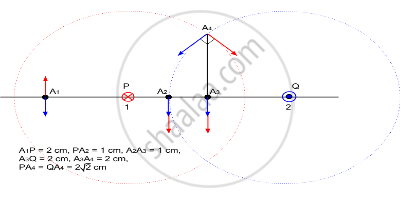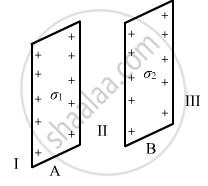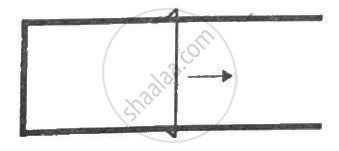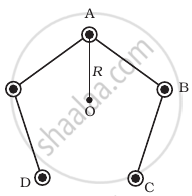Advertisements
Advertisements
Question
Figure shows two parallel wires separated by a distance of 4.0 cm and carrying equal currents of 10 A along opposite directions. Find the magnitude of the magnetic field B at the points A1, A2, A3.

Solution
For point A1,
Magnitude of current in wires, I = 10 A
Separation of point A1 from the wire on the left side, d = 2 cm
Separation of point A1 from the wire on the right side, d' = 6 cm

In the figure
Red and blue arrow denotes the direction of magnetic field due to the wire marked as red and blue respectively.
P (marked red) denotes the wire carrying current in a plane going into the paper.
Q (marked blue) denotes the wire carrying current in a plane coming out of the paper.
Also from the figure, we can see that
\[P A_4 = Q A_4 \]
\[\angle A_4 A_3 P = \angle A_4 A_3 Q = 90^\circ \]
\[ \Rightarrow \angle A_4 P A_3 = \angle A_4 Q A_3 = 45^\circ \]
\[ \Rightarrow \angle P A_4 A_3 = \angle Q A_4 A_3 = 45^\circ \]
\[ \Rightarrow \angle P A_4 Q = 90^\circ \]
The magnetic field at A1 due to current in the wires is given by
\[B = \frac{\mu_0 I}{2\pi d} - \frac{\mu_0 I}{2\pi d'}\] ...(1)
\[\Rightarrow B = \frac{2 \times {10}^{- 7} \times 10}{2 \times {10}^{- 2}} - \frac{2 \times {10}^{- 7} \times 10}{6 \times {10}^{- 2}}\]
\[ = \left( 1 - \frac{1}{3} \right) \times {10}^{- 4} \]
\[ = 0 . 67 \times {10}^{- 4} T\]
Similarly, we get the magnetic field at A2 using eq. (1).
\[B = \frac{2 \times {10}^{- 7} \times 10}{1 \times {10}^{- 2}} + \frac{2 \times {10}^{- 7} \times 10}{3 \times {10}^{- 2}}\]
\[ = \frac{8}{3} \times {10}^{- 4} T\]
\[ = 2 . 67 \times {10}^{- 4} T\]
Now,
Magnetic field at A3:
\[B = \frac{2 \times {10}^{- 7} \times 10}{2 \times {10}^{- 2}} + \frac{2 \times {10}^{- 7} \times 10}{2 \times {10}^{- 2}}\]
\[ = 2 \times {10}^{- 4} T\]
Separation of point A4 from the wire on the left side, d = \[\sqrt{2^2 + 2^2} = 2\sqrt{2} \] cm
\[B = \sqrt{\left( \frac{2 \times {10}^{- 7} \times 10}{2\sqrt{2} \times {10}^{- 2}} \right)^2 + \left( \frac{2 \times {10}^{- 7} \times 10}{2\sqrt{2} \times {10}^{- 2}} \right)^2}\]
\[ = 1 \times {10}^{- 4} T\]
APPEARS IN
RELATED QUESTIONS
Using the concept of force between two infinitely long parallel current carrying conductors, define one ampere of current.
How does one understand this motional emf by invoking the Lorentz force acting on the free charge carriers of the conductor? Explain.
Two long straight parallel conductors 'a' and 'b', carrying steady currents Ia and Ib are separated by a distance d. Write the magnitude and direction of the magnetic field produced by the conductor 'a' at the points along the conductor 'b'. If the currents are flowing in the same direction, what is the nature and magnitude of the force between the two conductors?
Two infinitely large plane thin parallel sheets having surface charge densities σ1 and σ2 (σ1 > σ2) are shown in the figure. Write the magnitudes and directions of the net fields in the regions marked II and III.

Derive the expression for force per unit length between two long straight parallel current carrying conductors. Hence define one ampere.
An electron is moving along the positive x-axis. You want to apply a magnetic field for a short time so that the electron may reverse its direction and move parallel to the negative x-axis. This can be done by applying the magnetic field along
(a) y-axis
(b) z-axis
(c) y-axis only
(d) z-axis only
Two parallel, long wires carry currents i1 and i2 with i1 > i2. When the currents are in the same direction, the magnetic field at a point midway between the wires is 10 µT. If the direction of i2 is reversed, the field becomes 30 µT. The ratio i1/i2 is
A long, straight wire of radius R carries a current distributed uniformly over its cross section. T he magnitude of the magnetic field is
(a) maximum at the axis of the wire
(b) minimum at the axis of the wire
(c) maximum at the surface of the wire
(d) minimum at the surface of the wire.
A copper wire of diameter 1.6 mm carries a current of 20 A. Find the maximum magnitude of the magnetic field `vecB` due to this current.
A transmission wire carries a current of 100 A. What would be the magnetic field B at a point on the road if the wire is 8 m above the road?
A hypothetical magnetic field existing in a region is given by `vecB = B_0 vece` where `vece`_r denotes the unit vector along the radial direction. A circular loop of radius a, carrying a current i, is placed with its plane parallel to the x−y plane and the centre at (0, 0, d). Find the magnitude of the magnetic force acting on the loop.
Figure shows a metallic wire of resistance 0.20 Ω sliding on a horizontal, U-shaped metallic rail. The separation between the parallel arms is 20 cm. An electric current of 2.0 µA passes through the wire when it is slid at a rate of 20 cm s−1. If the horizontal component of the earth's magnetic field is 3.0 × 10−5 T, calculate the dip at the place.

Two parallel wires carry equal currents of 10 A along the same direction and are separated by a distance of 2.0 cm. Find the magnetic field at a point which is 2.0 cm away from each of these wires.
If a current I is flowing in a straight wire parallel to x-axis and magnetic field is there in the y-axis then, ______.
Five long wires A, B, C, D and E, each carrying current I are arranged to form edges of a pentagonal prism as shown in figure. Each carries current out of the plane of paper.

- What will be magnetic induction at a point on the axis O? AxisE is at a distance R from each wire.
- What will be the field if current in one of the wires (say A) is switched off?
- What if current in one of the wire (say) A is reversed?
Two long parallel wires kept 2 m apart carry 3A current each, in the same direction. The force per unit length on one wire due to the other is ______.
